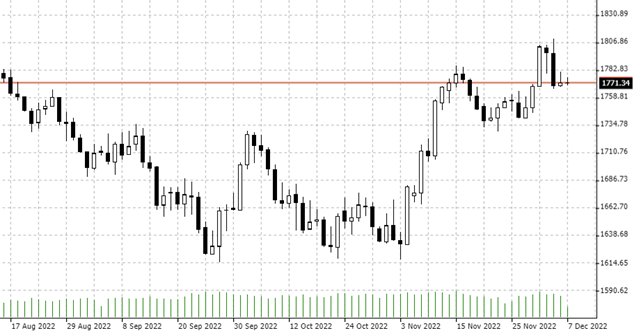

09.12.2022 – From a 12-month perspective, the oil price has slipped into negative territory. The oil price has been hitting new lows for the year non-stop anyway. The reason: the world is probably falling into recession after all.
The experts at Citigroup, at any rate, definitely see a global recession. WTI could therefore plunge to around 65 dollars by the end of this year and even to 45 dollars by the end of 2023. This is because oil consumption in the major economies in the USA, China and Europe could fall significantly over many months. Historically, oil prices have always fallen to about the level of production costs during global recessions, the statement added. Here is the daily chart of WTI.

Source: Bernstein Bank GmbH
Vishnu Varathan, head of Asia Economics and Strategy at Mizuho Bank, also told Bloomberg, “Oil has been dragged lower by broader recession fears that accompany global monetary policy tightening.”
Keystone Pipeline
That leaves one actually bullish factor that has been briefly supportive in the market so far. The loss of about 600,000 barrels per day from the Keystone pipeline should actually pull the market up. At least that stopped the downtrend, judged Ed Moya, senior market analyst at Oanda Corp. We interject: you can imagine what will happen once the news comes in on the realtime news that the pipeline is pumping at full capacity again. Operator TC Energy Corp. shut down the pipeline after a leak in Nebraska.
China’s opening
Another factor that is actually bullish is China opening up and moving away from drastic Corona measures. Meanwhile, the White House left open whether or not the Strategic Petroleum Reserve will now be replenished soon. Meanwhile, the price cap on Russian oil has no immediate effect, according to oilprice.com – hopes of a bullish impact have faded. Traders had therefore begun to sell.
Congestion on the Bosphorus
In addition, the oil market is watching developments on the Bosphorus, where 19 oil tankers were recently jammed. According to oilprice.com, Turkey has changed its insurance rules, traders are confused. And so now 20 million barrels from Kazakhstan were cruising around in Turkish waters. We are curious whether the oil price turns and keep you up to date!
__________________________________________________________________________________________
The content of this publication is for general information purposes only. In this context, it is neither an individual investment recommendation or advice nor an offer to purchase or sell securities or other financial products. The content in question and all the information contained therein do not in any way replace individual investor- or investment-oriented advice. No reliable forecast or indication for the future is possible with respect to any presentation or information on the present or past performance of the relevant underlying assets. All information and data presented in this publication are based on reliable sources. However, Bernstein Bank does not guarantee that the information and data contained in this publication is up-to-date, correct and complete. Securities traded on the financial markets are subject to price fluctuations. A contract for difference (CFD) is also a financial instrument with leverage effect. Against this backdrop, CFD trading involves a high risk up to the point of total loss and may not be suitable for all investors. Therefore, make sure that you have fully understood all the correlating risks. If necessary, ask for independent advice. CFDs are complex instruments and are associated with the high risk of losing money quickly because of the leverage effect. 68% of retail investor accounts lose money trading CFD with this provider. You should consider whether you understand how CFD work and whether you can afford to take the high risk of losing your money.7
